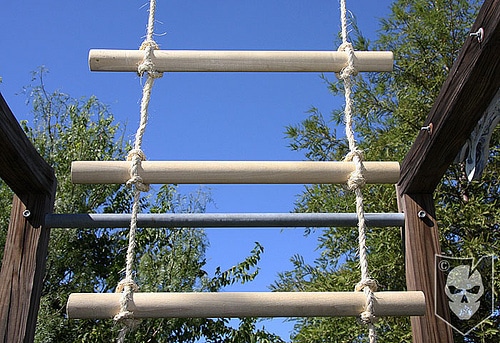To build a rope ladder, start by cutting the rope into desired lengths and spacing the rungs evenly. Then, tie the rungs to the side ropes using a sturdy knot such as a square knot or a timber hitch.
Building a rope ladder can be a fun and practical project for various purposes, such as for treehouses, boats, or emergency situations. Rope ladders are relatively simple to construct and require minimal materials, making them accessible for most DIY enthusiasts.
By following a few straightforward steps and using commonly available tools and materials, you can create a functional and durable rope ladder to suit your specific needs. Whether for recreational or practical use, a well-built rope ladder can provide added convenience and safety in various scenarios.

Credit: www.artofmanliness.com
Choosing The Right Materials
When it comes to building a rope ladder, choosing the right materials is crucial for its strength and durability. This section will guide you through selecting the appropriate ropes and woods for your project.
Rope Selection
- Look for ropes labeled as strong and durable
- Opt for nylon or polypropylene ropes
- Avoid cotton ropes as they can rot and are less sturdy
Wood Selection
- Choose hardwood such as oak or ash for durability
- Avoid softwoods like pine which may not withstand outdoor elements
- Ensure the wood is treated or sealed to prevent rotting

Credit: www.wikihow.com
Measuring And Cutting The Ropes
When building a rope ladder, one of the crucial steps is measuring and cutting the ropes appropriately. This stage ensures the ladder will be the correct length and each rung will be evenly spaced.
Determining Ladder Length
Start by determining the desired length of your ladder based on where it will be used and how high you need to climb. Measure twice to ensure accuracy.
Cutting The Rope
To begin, cut the rope to the desired length using a sharp pair of scissors or a knife. Ensure each rope is the same length for consistency.
Adding Rungs To The Ladder
Once you have completed the initial steps of designing and constructing the main framework for your rope ladder, it’s time to add the rungs. The rungs are the horizontal bars that provide stability and allow you to climb up and down the ladder. In this section, we will discuss two important aspects of adding rungs to your ladder: selecting the rung materials and spacing the rungs evenly.
Selecting Rung Materials
Choosing the right materials for your ladder’s rungs is crucial for both safety and durability. You need to ensure that the materials you select are strong enough to support your weight and withstand the test of time. Here are a few options to consider:
- Wood: Wood is a popular choice for ladder rungs due to its strength and natural aesthetic. Hardwoods like oak and ash are commonly used, as they can handle heavy loads without bending or breaking. Make sure to choose treated or weather-resistant wood to prevent rotting or damage caused by exposure to the elements.
- Metal: Metal rungs, such as aluminum or steel, offer excellent durability and strength. They are resistant to weather conditions and can support heavy loads. However, metal rungs may be more expensive than other options and may require extra safety measures to prevent slipping.
- Plastic: Plastic rungs are lightweight, affordable, and resistant to corrosion. They are a popular choice for DIY projects and are suitable for lighter weight requirements. However, keep in mind that plastic rungs may not be as strong as wood or metal options, so they may not be suitable for heavy-duty applications.
Spacing The Rungs
Properly spacing the rungs on your ladder is essential to ensure safe and comfortable climbing. You want to avoid having rungs that are too far apart, making it difficult to climb, or too close together, causing discomfort and potentially leading to accidents. Here are some guidelines to help you space the rungs evenly:
- Measure and mark: Start by measuring the desired distance between the top and bottom rungs. Divide this distance into equal sections to determine how many rungs you will need. Using a measuring tape, mark the spots where each rung will be attached.
- Consider safety: Keep in mind that the ideal spacing between rungs is around 10 to 12 inches. This distance provides a comfortable grip and minimizes the risk of slipping or missing a step. If you are building the ladder for children, consider making the spacing slightly shorter to accommodate their smaller reach.
- Attach the rungs: With the marked spots as your guide, secure each rung to the side ropes of the ladder. Make sure they are level and securely fastened to prevent any wobbling or instability.
By carefully selecting the right rung materials and spacing them evenly, you can create a sturdy and functional rope ladder for your various climbing needs. Take the time to plan and execute these steps correctly to ensure a safe and reliable ladder that will serve you well for years to come.
Attaching The Rungs To The Ropes
In order to securely attach the rungs to the ropes, there are a few key steps to follow. By properly creating holes in the rungs and securing them in place, you can build a strong and reliable rope ladder that will serve its purpose effectively.
Creating Holes In The Rungs
To create holes in the rungs, you will need to measure and mark the positions for each hole, ensuring they are evenly spaced. Use a drill with a bit that matches the diameter of the rope, and carefully drill through the rungs at the marked spots. This will allow the ropes to pass through the rungs securely, forming the ladder steps.
Securing The Rungs
After creating the holes, it’s important to secure the rungs in place. Thread the ropes through the holes in the rungs, ensuring they are positioned uniformly. Tie knots above and below each rung to prevent them from sliding out of place. Test the ladder to ensure the rungs are securely attached and adjust the knots as needed to achieve a strong and level ladder.
Creating The Ladder Structure
To start forming the ladder structure, lay out the two long ropes parallel to each other. Then, cut the smaller rungs to the desired length ensuring they are equally spaced apart.
After cutting the rungs, tie each rung to the long ropes using a sturdy and reliable knot. Make sure to maintain an equal distance between each rung to ensure the ladder’s stability.
Testing The Ladder
Discover the step-by-step guide on creating a sturdy rope ladder for various purposes. A detailed explanation on testing the ladder’s stability and construction process. Master the art of building a reliable rope ladder for your next project.
Once you have successfully built your rope ladder, it is crucial to test its weight capacity and stability to ensure safety during use. Testing the ladder should be done before relying on it for any tasks or activities.
Weight Capacity Test
Start by determining the weight capacity of your rope ladder. This will help you understand how much weight the ladder can safely hold. To conduct the weight capacity test:
- Attach a weight to the ladder, such as a sandbag or weights from a dumbbell set.
- Carefully climb the ladder a few steps and test its stability.
- If the ladder feels secure, gradually increase the weight until you reach the maximum load capacity.
- Monitor the ladder for any signs of stress, such as sagging or fraying ropes.
- If the ladder can handle the maximum weight capacity without any issues, it is deemed safe for use.
Stability Test
Ensuring the ladder’s stability is essential for your safety. To conduct the stability test:
- Position the ladder against a secure structure, such as a sturdy tree or wall.
- Climb a few steps and make sure the ladder remains stable.
- Gently shake or move the ladder to check for any wobbling or loosening of the ropes.
- If the ladder stays stable during these tests, it is ready for use.
Remember, testing the ladder thoroughly is essential for safety. Regularly inspecting the ladder for wear and tear, and retesting if any modifications are made, will ensure continued safety during each use.

Credit: www.instructables.com
Frequently Asked Questions Of How To Build A Rope Ladder
How To Choose The Right Type Of Rope For A Ladder?
For a rope ladder, it’s essential to choose a durable and weather-resistant rope material like nylon or polyester. Ensure it can withstand the weight capacity and environmental factors for long-term use.
What Are The Important Safety Measures To Consider While Building A Rope Ladder?
Safety is paramount when constructing a rope ladder. Ensure secure knots, proper tension, and regular inspections for wear and tear to avoid accidents. Also, consider the height and placement of the ladder for safe access.
Can I Use A Rope Ladder For Emergency Escape Purposes?
Yes, a well-constructed and securely anchored rope ladder can be a suitable emergency escape option. However, always consult local building codes and safety standards to ensure compliance with regulations for emergency use.
Conclusion
Building a rope ladder is a practical and fun skill that anyone can learn. By following the step-by-step instructions provided in this blog post, you can create a sturdy and reliable rope ladder for various purposes. Whether it’s for treehouses, emergency escape routes, or even just backyard entertainment, this DIY project offers versatility and creativity.
So, gather your materials and start building your own rope ladder today! Don’t miss out on the opportunity to enhance your outdoor experience with this simple yet exciting project.
{ “@context”: “https://schema.org”, “@type”: “FAQPage”, “mainEntity”: [ { “@type”: “Question”, “name”: “How to choose the right type of rope for a ladder?”, “acceptedAnswer”: { “@type”: “Answer”, “text”: “For a rope ladder, it’s essential to choose a durable and weather-resistant rope material like nylon or polyester. Ensure it can withstand the weight capacity and environmental factors for long-term use.” } } , { “@type”: “Question”, “name”: “What are the important safety measures to consider while building a rope ladder?”, “acceptedAnswer”: { “@type”: “Answer”, “text”: “Safety is paramount when constructing a rope ladder. Ensure secure knots, proper tension, and regular inspections for wear and tear to avoid accidents. Also, consider the height and placement of the ladder for safe access.” } } , { “@type”: “Question”, “name”: “Can I use a rope ladder for emergency escape purposes?”, “acceptedAnswer”: { “@type”: “Answer”, “text”: “Yes, a well-constructed and securely anchored rope ladder can be a suitable emergency escape option. However, always consult local building codes and safety standards to ensure compliance with regulations for emergency use.” } } ] }
